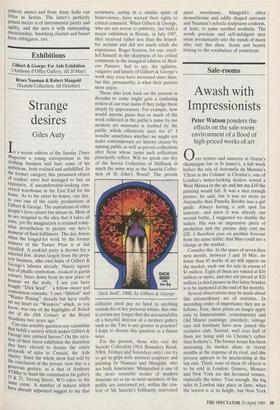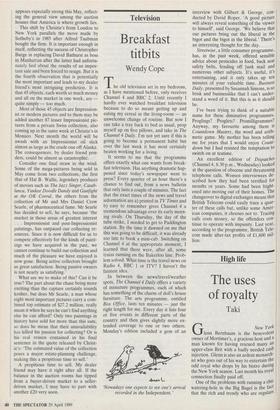Sale-rooms
Awash with Impressionists
Peter Watson ponders the effects on the sale-room environment of a flood of high-priced works of art
0 ver oysters and sancerre at Green's champagne bar in St James's, a full week before the sale of Antonella da Messina's 'Christ at the Column' at Christie's, one of London's better-looking dealers waved a West Mersea in the air and bet me £10 the painting would fail. It was a nice enough picture, he said, but it was no more an Antonello than Pamella Bordes was a girl guide. Always having a soft spot for sancerre, and since it was already our second bottle, I suggested we double the stakes. His was an impressive piece of prediction and the picture duly cost me £20. I therefore pass on another forecast from the same stable: that May could see a change in the market.
Consider this. In the space of seven days next month, between 3 and 10 May, no fewer than 45 works of art will appear on the market, each one for sale in excess of $1 million. Eight of them are valued at $10 million or more, and two are priced at $20 million (a third picture in this latter bracket is to be auctioned at the end of the month).
Several observations may be made about this extraordinary set of statistics. In ascending order of importance they are as follows. First, these prices no longer apply only to Impressionist, contemporary and Old Master paintings: jewellery, vintage cars and furniture have now joined this exclusive club. Second, well over half of them are being sold via Christie's rather than Sotheby's. The former house has been increasing its market share in recent months at the expense of its rival, and this process appears to be accelerating at the top end. Third, none of these 45 objects is to be sold in London: Geneva, Monaco and New York are the favoured venues, especially the latter. True enough, the big sales in London take place in June, when the season is at its height, but New York appears especially strong this May, reflect- ing the general view among the auction houses that America is where growth lies.
This shift by Christie's from London to New York parallels the move made by Sotheby's in 1985 after Alfred Taubman bought the firm. It is important enough in itself, reflecting the success of Christopher Burge in replacing David Bathurst as boss in Manhattan after the latter had unfortu- nately lied about the results of an impor- tant sale and been forced to resign. But it is the fourth observation that is potentially the most important and leads to my dealer friend's most intriguing prediction. It is that 45 objects, each worth so much money and all on the market in one week, are — quite simply — too much.
Most of those 45 objects are Impression- ist or modern pictures and to them may be added another 87 lesser Impressionist pic- tures from a private Swiss collection, also coming up in the same week at Christie's in Monaco. Next month the world will be awash with an Impressionist oil slick almost as large as the crude one off Alaska. The consequences, by dealer friend pon- ders, could be almost as catastrophic.
Consider one final straw in the wind. Some of the mega-pictures being sold in May come from two collections, the first that of Hal B. Wallis, legendary producer of movies such as The Jazz Singer, Casab- lanca, Yankee Doodle Dandy and Gunfight at the OK Corral, the others from the collection of Mr and Mrs Daniel Crow Searle, of pharmaceutical fame. Mr Searle has decided to sell, he says, because 'the market in those areas of greatest interest . . . Impressionist and post-Impressionist paintings, has outpaced our collecting re- sources. Since it is now difficult for us to compete effectively for the kinds of paint- ings we have acquired in the past, we cannot continue to build our collection and much of the pleasure we have enjoyed is now gone. Being active collectors brought us great satisfaction. Being passive owners is not nearly as satisfying.'
What are we to make of this? Can it be true? The part about the chase being more exciting than the capture certainly sounds kosher, but does Mr Searle, a man whose eight most important pictures carry a com- bined top estimate of $27.2 million, really mean it when he says he can't find anything else he can afford? Only two paintings in history have sold for more than this sum, so does he mean that their unavailability has killed his passion for collecting? Or is his real reason contained in his final sentence in the quote released by Christ- ie's: 'The estimated value of the collection poses a major estate-planning challenge, making this a propitious time to sell.'
A propitious time to sell. My dealer friend may have it right after all. If the balance in the auction rooms has tipped from a buyer-driven market to a seller- driven market, I may have to part with another £20 very soon.



















































 Previous page
Previous page